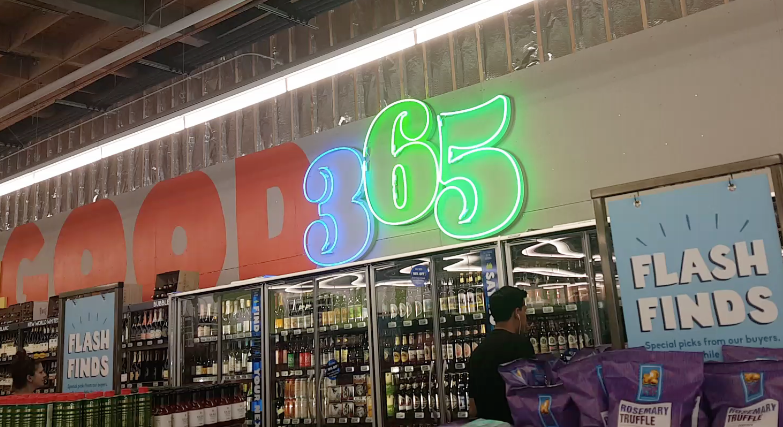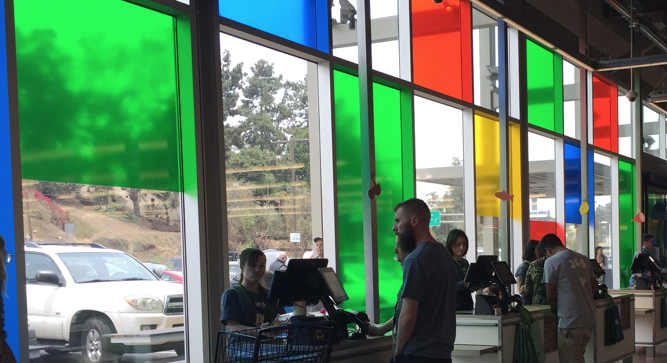Half Paycheck?


365 by Whole Foods, the new grocery store concept with a focus on lower prices, opened in Los Angeles’ Silver Lake neighborhood in May 2016. While many would assume that the shopping experience at 365 is comparable to that at Whole Foods, just one visit will prove that isn’t the case.
So, why did Whole Foods do something so radical and create a new grocery store for younger adults?
The 28,000-square-foot Silver Lake flagship store is designed with Millennials in mind, complete with low prices, high-tech amenities and the very notable absence of customer service. Inside the store, customers can sip on a cup of tea from the hot tea-dispensing TeaBOT machine (yes, young folks are into tea), food orders can be placed on a smartphone application, and booze can be identified and properly paired with fresh food on a tablet. So, why did Whole Foods do something so radical and create a new grocery store for younger adults? The answer is simple: young people haven’t learned to care about Whole Foods yet. As a Shook Kelley Los Angeles college intern, I am still figuring out the grocery stores I like best and waiting to see who might win me over. Before my trip to 365, Whole Foods wasn’t even in the running. Now it is, not just because of the quality of their product, but because of their excellence in delivering a quality shopping experience.
365 responds to Millennials with tighter budgets, because young adults are just starting their careers and many are saddled with student loan debt. Meanwhile, the cost of living, especially in the major urban areas that Millennials find most appealing, like Los Angeles, are outpacing any visible rise in income. To a certain degree, this has always been a predicament for younger adults just starting out. But one other difference today is the competitive environment for food retailers. Whereas in the past, traditional grocery stores could make their appeal to younger adults and their young families, today there is a bigger variety of store options, not to mention QSR, food-to-go and online services. The idea of Whole Foods is compelling, but brands like Trader Joe’s and Aldi are far less expensive; while they don’t offer the same quality in produce or the same variety in organic goods, they more than make up for it in international discoveries, easy to prep meals and food culture exploration. In order to fight the “Whole Paycheck” perception, whether true or not, Whole Foods has decided to simply start an entirely new food destination brand (which could have more fittingly been called “Half Paycheck”).
Almost exclusively selling the Whole Foods 365 private label products, the company has taken a minimalistic approach in order to keep prices down.
Walking through the automatic sliding doors at the 365 prototype store in Silver Lake, it’s clear that Whole Foods is trying to connect with a younger audience. From signs encouraging headphone-wearing youth to “rock out with us on Spotify,” to the bright orange “Come On In” sign that leads you into a controlled temperature room that’s perfect for storing fresh produce, tremendous efforts have been made to have 365 stand alone and be completely different from the standard Whole Foods store—or any other food retailer, for that matter. Almost exclusively selling the Whole Foods 365 private label products, the company has taken a minimalistic approach in order to keep prices down.
Whole Foods’ decision to mostly sell their private label food products was strategic, and timely. In most grocery stores, the most “desired” product tends to be the national name brands, and it takes removing that choice to realize that sometimes the private label brand is just as good, if not better. 365’s colorful logo for their private label seems to be plastered across just about every can or bag in the marketplace. From colorful blue corn tortilla chips to organic guacamole, it’s clear that Whole Foods did not sacrifice their reputation for flavor or culture in the making of their private label products. According to Mintel’s 2015 “Private Label Goods: What’s Driving Purchase?” report, 42 percent of Millennials (age 19-37) actually consider store brand food products more innovative than name brand CPG products. In addition, more than one third (37%) of United States shoppers today are preferring to buy store brand products over name brand products. The approach at 365 mimics the success of other smaller format stores like Trader Joe’s, almost solely focused on offering private label products in order to build the retailer’s brand.
It’s clear that Whole Foods set out to create a new kind of grocery store that, like Millennials, is on-the-go and quick to adapt.
While 365 lacks the high-end grocery store vibe of a traditional Whole Foods marketplace, it has a colorful, open design that is sure to make everyone’s shopping experience a pleasure. Despite the lack of customer service (a strategic move that not only cuts cost out of the operation, but is acceptable in an era of Millennials’ technology dependency), the store feels easy to navigate and fun to shop at. It’s clear that Whole Foods set out to create a new kind of grocery store that, like Millennials, is on-the-go and quick to adapt. The store itself is proof that while retail and how we shop changes with time, the need to convene remains the same. All 365 needs now is a barber to trim those hipster bears and a modest vinyl record selection at the front of the store, and the kids will never want to shop anywhere else.